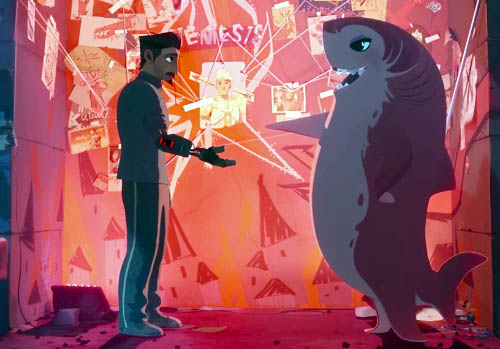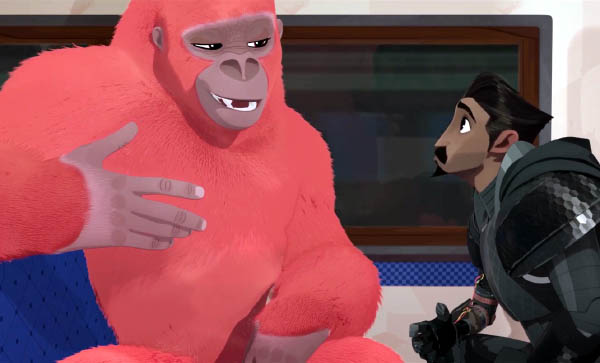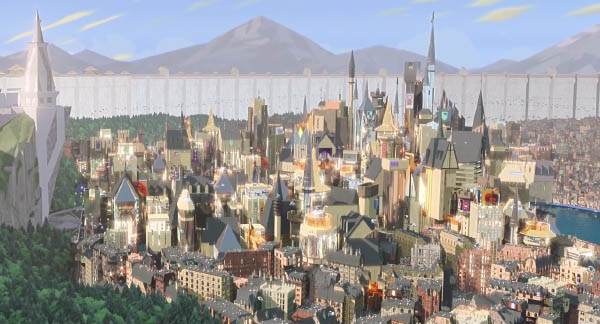Movie review: 'Nimona' (2023)
 Nimona (trailer) is a 99-minute American animated movie released in 2023. It was eventually directed by Nick Bruno and Troy Quane, with a script by Robert Baird and Lloyd Taylor (plus additional writers), and was adapted from a webcomic/graphic novel by ND Stevenson. Originally it was produced by Blue Sky Studios, whose parent company was acquired by Disney before the project was finished. Disney cancelled it, likely due to its overt LGBTQ+ themes, and closed down Blue Sky to focus on their own, pre-existing animation studios. Luckily, they were willing to let Netflix acquire the rights, and it was completed by DNEG Animation and Annapurna Pictures.
Nimona (trailer) is a 99-minute American animated movie released in 2023. It was eventually directed by Nick Bruno and Troy Quane, with a script by Robert Baird and Lloyd Taylor (plus additional writers), and was adapted from a webcomic/graphic novel by ND Stevenson. Originally it was produced by Blue Sky Studios, whose parent company was acquired by Disney before the project was finished. Disney cancelled it, likely due to its overt LGBTQ+ themes, and closed down Blue Sky to focus on their own, pre-existing animation studios. Luckily, they were willing to let Netflix acquire the rights, and it was completed by DNEG Animation and Annapurna Pictures.
And I am the wrong person to be reviewing this movie.
In my years of writing reviews, this is the second time this has happened. The first time was when Kyell Gold sent me a copy of Green Fairy to review. By no fault of Kyell's, or the story itself, aspects of the book set off multiple buttons in my head due to personal experiences from my past. This caused my brain to mis-map story elements, and it didn't work for me. I tried writing a review, and I couldn't bring myself to publish it at the time. It wasn't fair to the book, nor to Kyell's writing craft.
And so now I'm facing a similar dilemma with Nimona. This time, I'm going to attempt a review, but without all of my internal brain slop. You'll be getting some of it, but believe me when I say I'm leaving a lot out. (Deep breaths. Focus on the positive.) At this point the film is two years old and I'm assuming that most folks here have seen it, so I'm not going to be shy about major plot details.
However, despite my personal opinions, let me be clear: If you haven't watched this film, it's worth a watch. It's good. It's just I'm not the audience it's for. And that's ok! I still appreciate it for what it is. Stop reading here to avoid spoilers.
Recap: There's a technologically advanced walled city that has a 1000-year-old tradition in which the descendants of noble families can become knights of the Institute, an elite squad of fighters to protect the city in case of monster attacks. A man of lowly birth named Ballister is about to be knighted by the Queen, a controversial act, as he's the first commoner to receive such an honor, thanks to the Queen's lifelong support. We see a couple members of the public unhappy about it, but in the stadium where the ceremony takes place, it sounds like most of the audience supports this change. Alas, someone has other opinions - Ballister's sword has been tampered with, and it's used to assassinate the Queen.
 Now that Ballister is on the run, he's approached by a strange, pink-haired young woman named Nimona who announces she's his new villain sidekick, only to be disappointed that Bal doesn't view himself as a villain. Her motives at first appear to be about taking down the government, revenge for being rejected by society, and seeing in Bal a kindred spirit, due to becoming an enemy of the state. She frees Bal when he's captured, and together they improvise a way to clear his name. The villain turns out to be the Director of the Institute, xenophobically opposed to changing 1000 years of tradition, and willing to go to extreme, murderous lengths to do so.
Now that Ballister is on the run, he's approached by a strange, pink-haired young woman named Nimona who announces she's his new villain sidekick, only to be disappointed that Bal doesn't view himself as a villain. Her motives at first appear to be about taking down the government, revenge for being rejected by society, and seeing in Bal a kindred spirit, due to becoming an enemy of the state. She frees Bal when he's captured, and together they improvise a way to clear his name. The villain turns out to be the Director of the Institute, xenophobically opposed to changing 1000 years of tradition, and willing to go to extreme, murderous lengths to do so.
Nimona herself refuses to explain who (or what) she is to Bal, other than saying she's Nimona. It turns out she's a long-lived shapeshifter, who can assume the form of any person or animal. By the last act of the film it's revealed she's the monster that the entire walled city has been obsessed with protecting itself from, originating from being demonized by her only childhood friend 1000 years ago, for being different. The Institute, the city and its generations of defensive propaganda have all been based on an incident of judgemental discrimination, personally directed at her.
Bal and Nimona temporarily manage to reveal the truth about the Director, but the Director spins the situation the other way and projects the blame back onto Nimona. This creates enough doubt in Bal that he's no longer sure he can trust her, and walks away. Nimona has an emotional breakdown due to centuries of rejection and turns into a giant monster that begins to storm through the city, eventually attempting suicide. Bal has a change of heart and stops her.
 The Director, meanwhile, confronted by the very real embodiment of all her fears and prejudice, feels provoked to activate a weapon that would both kill Nimona and a large part of the city's populace, despite the protests of the knights, and ignoring that the danger has just been neutralized. Nimona absorbs the blast and appears to have been disintegrated. The populace accepts Bal and Nimona as heroes, after presumably being informed of the truth by Bal and the other knights. (It's not addressed.) Nimona re-appears to Bal at the end, still alive.
The Director, meanwhile, confronted by the very real embodiment of all her fears and prejudice, feels provoked to activate a weapon that would both kill Nimona and a large part of the city's populace, despite the protests of the knights, and ignoring that the danger has just been neutralized. Nimona absorbs the blast and appears to have been disintegrated. The populace accepts Bal and Nimona as heroes, after presumably being informed of the truth by Bal and the other knights. (It's not addressed.) Nimona re-appears to Bal at the end, still alive.
Before I can review this, I have to offer at least a bit of an explanation about why aspects of the film don't work for me, without info-dumping over 20 years of personal brain sludge. Mostly, it boils down to two things. Then I'll explain that I understand why the film needs to be the way it is.
My main issue is that, due to bullying growing up, I don't enjoy media with asshole protagonists. Fawlty Towers, a lot of Bill Murray's roles... I can appreciate the comedy, but I don't personally like the comedy, if that makes any sense. Nimona (the character) crosses that mental line inside of me, even though she rapidly switches between "fuck you and what you represent, small-minded establishment" asshole and the more tolerable "comedic animation" asshole. Unfortunately, due to some of her behavior and personality traits, my brain also immediately associates her with toxic people I went to high school with. But my feelings here don't matter - Nimona needs to be this character. More on that later.
My second issue is that my brain has a tendency to take animated films more seriously than it should. If you've been reading my reviews here for a while, you'll have noticed this is a running theme. Very often I openly question why I take some films very seriously, and others I don't. It's inconsistent, and that bothers me. I'm still trying to figure out why. Nimona, the film, for whatever reason, activated the nit-picking half of my brain, and that's bad.
Why? Because the film is constructed around allegory. Absolutely nothing wrong with that, just look at films like Get Out (2017) and District 9 (2009). The issue is, my brain wants to treat Nimona too seriously, putting its world-building first, then with allegory layered on top. And that's not how this film has constructed itself. It was built around its allegorical elements (rather heavy-handedly), so if something in the world-building doesn't make sense - it's not supposed to. So many things are touched on extremely briefly, and then aren't addressed in any significant way later.
Before writing this review, I went on a two-day bender of reading other reviews, to figure out how I felt, because I was having so much trouble articulating my thoughts. Saberspark had a really good review - it's been taken down, but I found a remnant I could watch - that I'm about 80% in agreement with. In parts of it, he bemoans that aspects of the story and world felt under-developed. My argument is that this is deliberate. The film wants you to focus on its allegorical elements first and foremost. Anything that feels under-developed, it's the film telling the viewer "Look, this aspect isn't really important, don't worry about it." Nit-picking what the film doesn't address would be a fascinating exercise, but aside from a few things mentioned below, it would take too long to address them all. There are other films I want to review after this one!

The allegory that the film is built around is to convey the trans experience of societal rejection. There were a lot of changes made from the original comic, and ND Stevenson insisted that Nimona (the film character) remain unchanged, to represent the subconscious experiences he'd been struggling with when he originally wrote it. So the writers and directors presented her in such a way that she could resonate with all sorts of people, and online there's much praise for this, including from the non-binary and those who've faced other forms of discrimination (due to stuttering, etc).
And this is why Nimona (the film character) has to be the way she is. She's against a society that unjustly rejects non-conformity such as [fill in the blank], so she's punk and anti-authoritarian. She's unapologetic about her behavior and whatever her identity is, so she can represent personal strength and resiliency to the audience, to encourage them to move beyond whatever victimization they've faced, and to express who they are, not what society would prefer them to be. There's only one of her, to represent the feelings of isolation and later, tragically, attempted suicide. And that's noteworthy, because typically when there's an allegorical story about a marginalized part of society, it's about a group. (The artistic choices in Art Spiegelman's Maus, for example.) She's mildly chonk with piercings, because screw Hollywood body image expectations. And she's pink because... uhh... I assume it's a color symbolism thing?
I felt let down by Bal. He's the supporting foil to Nimona, and although the film is about her (obviously), he felt so... weirdly passive and boring, at least in the first half of the film. Yet he must have struggled for years with people being against him (not addressed) in a society that had significant class differences (not addressed), so much so that it drove the Director to do what she did. And yet the first thing Bal does while on the run is single-handedly - literally - assemble a bionic arm out of parts lying around that can successfully fuse to his nervous system. So he shouldn't be boring and passive. He's obviously got hidden strengths and talents (not addressed), or the society's tech is so super-advanced, that this kind of thing is commonplace.
 But here's something I find absolutely delicious about the film: The prevalence of other historically marginalized groups being part of the system to be overthrown. You've got obviously gay characters such as Bal, his boyfriend Ambrosius, the squire and others. If you pay attention to the visuals and crowd scenes, you'll notice that the Queen, some knights, and a huge amount of the general populace are black. And Ambrosius himself, look at his eyes, they're
But here's something I find absolutely delicious about the film: The prevalence of other historically marginalized groups being part of the system to be overthrown. You've got obviously gay characters such as Bal, his boyfriend Ambrosius, the squire and others. If you pay attention to the visuals and crowd scenes, you'll notice that the Queen, some knights, and a huge amount of the general populace are black. And Ambrosius himself, look at his eyes, they're so dreamy coded as Asian. This is a brilliant way to quietly place emphasis on the intended direction of the story's allegory. "Oh, you think you've been discriminated against? Well how about something from our point of view for a change." To me, this is... (chef's kiss).
One thing that didn't occur to me as a plot element was homophobia. Very early on, we see a scene in which Ambrosius shows his affection for Bal, in private. Then when I was reading TVTropes, their Your-mileage-may-vary tab suggested that Bal couldn't be open about their relationship due to his identity. But Ambrosius' overt campiness certainly hasn't stopped him from becoming a media figure, or for the squire to reach his position in life. And their fellow knights seem aware that Bal and Ambrosius are at least close friends, so it's just as likely if they're quiet about their relationship, it's because of their class differences. But it's not addressed!
Another neat aspect of stories like this, is that just because there's a deliberate allegory, the creators have no control over what the audience's take will be. For me, since I'm not the target audience the allegory was written for, I kind of mentally set it aside and try to focus on other aspects of the film. I've done the same thing every time a Studio Ghibli film has hit me over the head with environmental themes. (I get it; now what else have you got, Miyazaki?) Another friend of mine, who watched Nimona a few months ago, his take was "totalitarian states are bad" and "we create non-conformists because of how we treat them", which I think is a really powerful observation.
(As an aside, I had a friend who was really into MLP:FiM and was gushing about the episode "Hearth's Warming Eve" and its message of friendship overcoming inter-group hatred. He was shocked that my take on it was "Neutralize your ideologically-obsessed leadership, and the saner, pragmatic lower government staff will actually be able to get things accomplished.")
Other aspects of the film: Animation and emotional expression, excellent. Voice acting, good performances all around! Character designs, so-so for me. Visuals in general, good! The Nostalgia Critic was complaining about the textures, and honestly I didn't have any problem with how things looked. In fact, in terms of 3D films trying to give themselves a flat, 2D look - I think Nimona has been one of the better examples I've seen so far. Music, didn't really notice it, which means it worked. Except when it went punk, and some bad memories came back. (To date, my fav punk song is a cover of "Common people" by Ben Folds and William Shatner.) Bonus points for putting in the theme to The Banana Splits!
This being a furry film review, I can definitely say I was delighted by Nimona's various animal forms, and wish there'd been more time spent with them on the screen! Assuming you don't mind pink and can ignore significant changes in mass out of nowhere. There was a moment where she's running as an otter and switches into a wolf form - the animation is beautifully smooth. I wasn't big into her human forms, although the creepy little boy had its moments.

Other random happy things: The knights arguing at two points about Nimona's otter species. Ambrosius' sudden realization while reviewing the security camera footage, "...He hates free-style jazz!" But the best of all? Blue Sky Studios getting their own shout-out section in the credits. Well-deserved.
Now that I've seen the film, even though I was the wrong fit for it, I can see why it was nominated for nine Annie Awards, of which it won two. And no surprise it won an Ursa Major Award! I was in a chat with a couple of furry fans who felt burnt out by what they felt was its in-your-face identity politics, and while I can understand that sentiment, I think Nimona was a story that needed to be told, and was why Netflix made it free to watch for a week.
There was a librarian in India named S.R. Ranganathan who in 1931 proposed five laws of library science, two of which were "Every person their book; Every book its reader". People need to feel heard and not alone in their struggles, and if you're part of a minority, it can be extremely empowering to see a character in a book or a film that represents you. In a time when the extreme right in the United States is abusing trans issues (and occasionally furry fandom) as a coded attack against all LGBTQ+ individuals, I think Nimona came at a very good moment. It reminded me of something I read online years ago. Because this kind of thing can literally make a difference in someone's life.
That being said, I probably won't watch this movie by myself again, due to the bad resonances it set off inside me. I've left out a lot of negativity and personal baggage opinions; it's taken me two days to write this, and I even lost sleep thinking about it. But if I meet someone who hasn't seen it, I'll ask them if they'd like to watch it, if they don't mind un-subtle allegories. And if they say yes, I will gladly watch it again with them, not because of the film, but because it's a gift of entertainment that I can share with another human being, with a movie I'm sure they'll appreciate. That means a lot to me.
Guilty confession: Up until now I had no idea Annapurna was a television and film production outfit. I'd thought they were only video game publishers.
Biggest regret? That none of us here at Flayrah reviewed this film when it came out. My personal apologies for being so late with it; I tend to leave the mainstream to others. How did you feel about Nimona? Let us know in the comments! Unless you think it's too "woke", in which case, you can go fuck yourself.


Comments
Post new comment